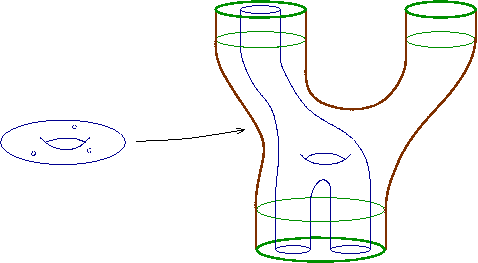Symplectic Field Theory is a general framework for defining invariants of
contact manifolds and symplectic cobordisms between them, using Gromov's
theory of pseudoholomorphic curves. First introduced
in a paper
by Eliashberg, Givental and Hofer in 2000, the ideas behind SFT
go back at least as far as Gromov's famous 1985 paper on
holomorphic curves and Floer's subsequent solution to the Arnold
conjecture on symplectic fixed points, which created a major industry in
the development of "Floer type" theories. After Hofer's introduction
in 1993 of finite-energy J-holomorphic planes to study the Weinstein conjecture
on periodic orbits of Hamiltonian systems, it became clear that one should
try to develop a Floer type theory based on punctured pseudoholomorphic
curves in symplectisations of contact manifolds. The algebraic
structure of the resulting theory turned
out to be significantly more elaborate than in the original Floer homology,
and its name derives partially from a certain similarity to topological
quantum field theories.
Its analytical difficulties are also formidable and, indeed, not all of
them have yet been satisfactorily dealt with.
The goal of this course will be to explain the algebraic structure of SFT
and the analytical and geometric phenomena that underlie that structure, and
to illustrate it with a few sample applications in which
computations can be carried out and lead to rigorously provable results.
A large portion of the course will deal with "standard" topics on the
analysis of pseudoholomorphic curves, and we will deal with these topics
in a rigorous way to the extent that time allows. An important caveat
to understand from the beginning is that even 15 years after the structure
of SFT was first sketched, its analytical foundations remain
work-in-progress, and one could base
an entire course
on the development of the rather non-standard methods required for these
analytical foundations. This is not that course, and as a consequence,
it will not be within our power to provide complete proofs that SFT has all
the structure it is meant to have, nor indeed that it is a well-defined
theory at all, except in a few very special cases.
At the present moment in its development, SFT should be thought of
less as a theory to be applied than as a source of inspiration: it can
often provide valuable intuition and suggest conjectures that then turn out
to be rigorously provable using more standard techniques. We will illustrate
this principle via applications to the classification of contact structures
and obstructions to symplectic fillings and cobordisms between certain
contact 3-manifolds.
The course is aimed mainly at PhD students in differential geometry or
related fields who are not afraid of analysis.
Some knowledge of the following topics in particular will be assumed:
|
Term 1:
|
|
Wednesday, 14 October
|
Introduction: history (Gromov '85, Floer homology,
Weinstein conjecture), contact manifolds and
symplectic cobordisms, sketch of the algebraic formalism
|
|
Wednesday, 21 October
|
Some basics on pseudoholomorphic curves: linearizations,
elliptic regularity, similarity principle, unique continuation
|
|
Monday, 26 October
|
Nonlinear regularity, asymptotic operators and spectral flow
|
|
Wednesday, 28 October
|
The Conley-Zehnder index, the Fredholm property on
surfaces with cylindrical ends
|
|
Wednesday, 18 November
|
Riemann-Roch on surfaces with cylindrical ends
|
|
Monday, 23 November
|
Stable Hamiltonian structures, symplectic cobordisms with stable boundary,
moduli spaces of asymptotically cylindrical pseudoholomorphic curves
|
|
Monday, 30 November
|
Nonlinear functional analytic setup, implicit function theorem,
transversality for generic J in cobordisms
|
Wednesday, 2 December
in room 500!
|
Proof of generic transversality in cobordisms and symplectizations
|
|
Monday, 7 December
|
Finite energy and asymptotics, bubbling and breaking,
sketch of the SFT compactness theorem
SFT compactness "animation"
|
|
Wednesday, 9 December
|
Cylindrical contact homology and an application to distinguishing
tight contact structures on the 3-torus
|
|
Term 2
|
|
Wednesday, 3 February
|
Determinant line bundles, coherent orientations, good vs. bad
orbits
|
|
Wednesday, 10 February
|
lecture postponed to 17 February
|
|
Wednesday, 17 February
|
The SFT generating function, grading and signs, combinatorics of gluing
|
|
Wednesday, 24 February
|
Full contact homology, rational and full SFT, BV-infinity algebra formalism,
cobordism maps and algebraic torsion
|
|
Wednesday, 2 March
|
Automatic transversality in dimension four, normal Chern number and
"wind-pi", consequences for orientations
(lecture notes will appear someday)
|
|
Wednesday, 9 March
|
Intersection numbers and adjunction formula for punctured holomorphic
curves
(lecture notes will appear someday)
|
|
Wednesday, 16 March
|
no lecture
|
|
Wednesday, 23 March
|
lecture postponed to 5 April
|
Tuesday, 5 April
in room 500!
|
Vanishing of contact homology and algebraic torsion computations
(lecture notes will appear someday)
|
